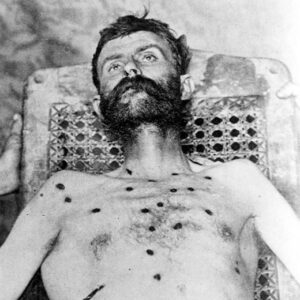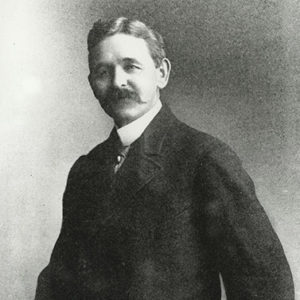calsfoundation@cals.org
Bill Doolin (1858–1896)
aka: William Doolin
William Doolin was an Arkansas-born outlaw who rode with the infamous Dalton outlaws in the Oklahoma Territory and Indian Territory. He formed his own outlaw bunch, which operated from October 1892 until Doolin died on August 25, 1896.
Though his exact date of birth is unknown, Bill Doolin’s tombstone states that he was born in 1858. He was born on a homestead near Big Piney Creek approximately thirty-five miles northeast of Clarksville (Johnson County). He was the son of sharecroppers Artemina and Michael Doolin and worked on his family’s farm until his twenty-third birthday.
In 1881, Doolin left Arkansas for the area that is now the state of Oklahoma and found employment as a cowboy on the ranch of Oscar D. Halsell in what was then called Logan, Oklahoma. After some restless drifting and trouble with the law, Doolin joined the infamous Dalton gang in 1891. Led by Robert (Bob) Dalton, with his brothers Gratton (Grat) and Emmett, the Daltons were labeled the “most cold-blooded robbers in the West.” The Daltons came from a family of fifteen, though only Bob, Grat, and Emmett Dalton—and, later, Bill—turned to a life of crime.
While riding with the Daltons, Doolin was reported to be with the gang when they robbed several trains and depots from May 1891 through July 14, 1892. Doolin decided to forego the gang’s ill-fated and final double bank robbery at Coffeyville, Kansas, on October 5, 1892, where only Emmett Dalton survived the legendary shootout in the streets.
After the Coffeyville fiasco, Doolin organized his own gang and, with an assortment of misfits, commenced to terrorize southern Kansas and the Oklahoma Territory and Indian Territory, robbing banks, trains, and stagecoaches over a four-year period. Nearly all these men met violent deaths, but not before the gang amassed a purported $165,000.
On July 1, 1893, Evett Dumas Nix, a Guthrie, Oklahoma, businessman, was appointed United States marshal under the jurisdiction of Judge Isaac Parker, the “Hanging Judge.” Nix quickly assembled an impressive group of over 100 field deputies, including Heck Thomas, Chris Madsen, and Bill Tilghman, known collectively as the “Three Guardsmen.”
Late in August, Nix was informed that the Doolin gang was in Ingalls, Oklahoma, and he dispatched Deputy Marshal John Hixson and a posse of thirteen to the town. It was in Ingalls that Doolin met and married Edith Ellsworth, the daughter of a part-time minister and purported town official. The Ingalls raid has been considered by many Western historians as the most deadly gun battle between outlaws and U.S. marshals in the history of the Southwest. Six men in the posse were wounded or killed on the streets during the raid, but Doolin and several others had escaped.
Elevated due to his intelligence and successes, William Tilghman was assigned as a United States marshal. He learned that Doolin had fled to Eureka Springs (Carroll County) to nurse his wounds and take the purported healing the powers of the springs. On January 15, 1896, Tilghman arrested Doolin in the Eureka Springs Bathhouse. Doolin was indicted in Stillwater, Oklahoma, for murder in connection with the Ingalls shootout. The U.S. District Attorney offered the outlaw fifty years in prison in exchange for a plea of guilty, but Doolin entered a plea of “not guilty,” telling a surprised Bill Tilghman later that fifty years was too long to stay in prison.
On the night of July 5, 1896, before his trial, Doolin and a number of inmates escaped from the Guthrie Federal Prison. Within an hour of the massive jail escape, Marshal Heck Thomas formed a posse and rode after the escapees but found none. Doolin made his way over the Cimarron Brakes towards Lawson, Oklahoma (now called Quay in Payne County), where his wife, Edith, and son were staying with her father on his farm nearby.
Thomas received information from a local blacksmith that Doolin was at his father-in-law’s homestead. On the night of August 25, 1896, Thomas and nine deputies went to the farm and hid near the house. When Doolin emerged from the barn, Thomas shouted for the outlaw to halt, but Doolin shot at the marshal instead. The posse, in turn, shot and killed Doolin. He is buried in Guthrie, Oklahoma.
For additional information:
Bearden, Russell E. “Last of the Arkansas Outlaws.” Jefferson County Historical Quarterly 15, no. 4 (1987).
Hanes, Bailey C. Bill Doolin, Outlaw. Norman: University of Oklahoma Press, 1968.
Nix, Evett Dumas. Oklahombres, Particularly the Wilder Ones. Lincoln: University of Nebraska Press, 1993.
Shirley, Glen, West of Hell’s Fringe: Crime, Criminals, and the Federal Peace Officer in Oklahoma Territory, 1889–1907. Norman: University of Oklahoma Press, 1978.
Underhill, Lonnie E. “The Killing of Bill Doolin, August 25, 1896.” Journal of the West 61 (Fall 2022): 45–55.
Western History Collection. University of Oklahoma Libraries, Norman, Oklahoma.
Russell E. Bearden
White Hall, Arkansas
This entry, originally published in Arkansas Biography: A Collection of Notable Lives, appears in the CALS Encyclopedia of Arkansas in an altered form. Arkansas Biography is available from the University of Arkansas Press.
 Law
Law Post-Reconstruction through the Gilded Age, 1875 through 1900
Post-Reconstruction through the Gilded Age, 1875 through 1900 Bill Doolin
Bill Doolin  Evett Dumas Nix
Evett Dumas Nix 




I grew up in Kansas City, Missouri. My family always said that Doolin died of consumption and that Bill Tilghman shot Doolin with a shotgun, collected the reward, and gave the reward to my aunt, who was Doolin’s wife. It is hard to know the truth.
Outlaw gangs that operated in the Indian Territory-Oklahoma Territory area were elusive because of jurisdiction. If they committed an offense in the Cherokee Nation, all they had to do was cross the river into the Choctaw Nation or cross a line into the Creek Nation because each tribe had its law enforcement officers, which had no jurisdiction in the other nations. The U.S. marshals had jurisdiction relating to whites who committed crimes, but by the time the report of a crime reached the Fort Smith court and the marshals were sent out or the Paris, Texas, court and the marshals were sent out, the gangs had gone somewhere else. Oklahoma Territory had its own U.S. marshals and courts. So when Doolin and his gang robbed the bank in Pawnee and the one in Red Rock, both in Oklahoma Territory, they ran back into the Indian Territory into another jurisdiction. Then there were the romantic, Robin Hood-like stories that floated among the general population of Oklahoma Territory and Arkansas Territory that added to the difficulty of catching the criminals. Whether people really believed them or reacted out of fear, they were reluctant to turn the outlaws in.